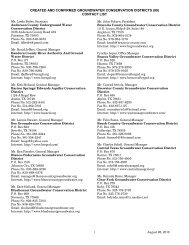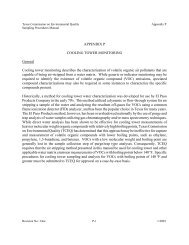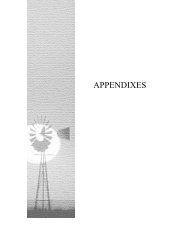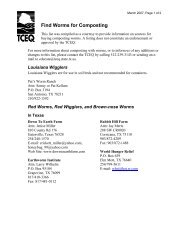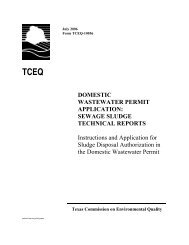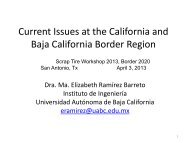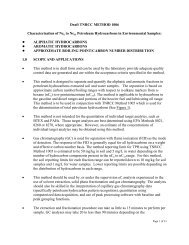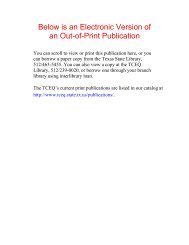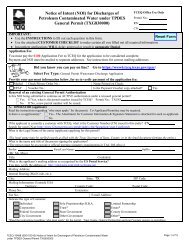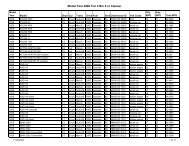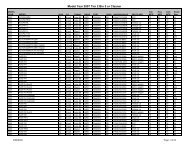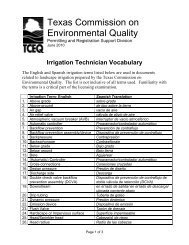Ecological Overlay for the Trinity River for support of Development of ...
Ecological Overlay for the Trinity River for support of Development of ...
Ecological Overlay for the Trinity River for support of Development of ...
Create successful ePaper yourself
Turn your PDF publications into a flip-book with our unique Google optimized e-Paper software.
Figure 133. Boxplot depicting historical median and quartiles <strong>of</strong> TSS levels in <strong>the</strong> <strong>Trinity</strong> <strong>River</strong><br />
Basin (source: TCEQ SWQM database, Map <strong>of</strong> segments = Figure 2). .................................... 118<br />
Figure 134. Location <strong>of</strong> water quality studies historically conducted within <strong>the</strong> <strong>Trinity</strong> <strong>River</strong><br />
basin. ........................................................................................................................................... 119<br />
Figure 135. Discharge and difference in nitrogen, phosphorus and sediment loads <strong>for</strong> sites above<br />
and below Livingston Reservoir, 1974-88 (Load differences were calculated by subtracting <strong>the</strong><br />
loads below Livingston Reservoir from <strong>the</strong> loads above Livingston Reservoir.) Reprinted from:<br />
(Van Metre and Reutter 1995). ................................................................................................... 124<br />
Figure 136. Historical Estimates <strong>of</strong> nitrogen loads. Source: (Jensen et al. 1991). ................... 126<br />
Figure 137. Total nitrogen loads estimated presented and cited by (Jensen et al. 2003). Original<br />
source: (Clingenpeel 2002)......................................................................................................... 126<br />
Figure 138. Average Daily Loads <strong>of</strong> total nitrogen and total phosphorus to and from Lake<br />
Livingston. From: (Jensen et al. 2003). ...................................................................................... 127<br />
Figure 139. Comparisons between total nitrogen and phosphorus removal. Sources:<br />
(Clingenpeel 2002; Jensen et al. 2003)....................................................................................... 128<br />
Figure 140. Estimated loads <strong>of</strong> total suspended solids into Galveston Bay from <strong>the</strong> <strong>Trinity</strong> <strong>River</strong><br />
at Romayor and from <strong>the</strong> San Jacinto <strong>River</strong> from 1969 through 1988. Source: (Armstrong and<br />
Ward Jr. 1993) ............................................................................................................................ 128<br />
Figure 141. Estimated loads <strong>of</strong> total nitrogen into Galveston Bay from <strong>the</strong> <strong>Trinity</strong> <strong>River</strong> at<br />
Romayor and from <strong>the</strong> San Jacinto <strong>River</strong> from 1969 through 1988. Source: (Armstrong and<br />
Ward Jr. 1993) ............................................................................................................................ 129<br />
Figure 142. Estimated loads <strong>of</strong> total phosphorus into Galveston Bay from <strong>the</strong> <strong>Trinity</strong> <strong>River</strong> at<br />
Romayor and from <strong>the</strong> San Jacinto <strong>River</strong> from 1969 through 1988. Source: (Armstrong and<br />
Ward Jr. 1993) ............................................................................................................................ 129<br />
Figure 143. Location <strong>of</strong> geomorphology study sites based on recent <strong>Trinity</strong> <strong>River</strong> literature<br />
review.......................................................................................................................................... 130<br />
Figure 144. Location <strong>of</strong> major geomorphic zones within <strong>the</strong> <strong>Trinity</strong> <strong>River</strong>. Source: (Phillips<br />
2008). Map taken from Phillips 2008. ........................................................................................ 131<br />
Figure 145. Location <strong>of</strong> published and unpublished fish studies archived in <strong>the</strong> EIH <strong>Trinity</strong><br />
<strong>River</strong> database that were used to document <strong>the</strong> historical distribution <strong>of</strong> fish species in <strong>the</strong> <strong>Trinity</strong><br />
<strong>River</strong> basin. ................................................................................................................................. 140<br />
Figure 146. Fish collections by Ecoregion. ............................................................................... 141<br />
Figure 147. Numbers <strong>of</strong> fish taxa reported during each study within <strong>the</strong> <strong>Trinity</strong> <strong>River</strong> basin. . 142<br />
Figure 148. Major land use categories present in <strong>the</strong> <strong>Trinity</strong> <strong>River</strong> basin................................. 143<br />
Figure 149. Location <strong>of</strong> fish collections obtained from literature review. Waterbody code is <strong>the</strong><br />
TCEQ segment number (see Table 2). Code 0000 denotes collections from uncertain locations<br />
or tributaries without a TCEQ segment number. Data includes collections from fish kills and<br />
reservoirs..................................................................................................................................... 144<br />
Figure 150. Location <strong>of</strong> fish collections obtained from literature review. Data from reservoirs<br />
and fish kills included. ................................................................................................................ 144<br />
Figure 151. Original fish guilds identified from cluster analysis <strong>of</strong> life history characteristics<br />
including trophic level, water quality tolerance and reproductive behavior. (Balon level 1)..... 147<br />
Figure 152. Fish guilds identified from cluster analysis based on life history characteristics<br />
including trophic level, water quality tolerance and reproductive behavior. (Balon level 1).<br />
Species list based on abbreviated list using some <strong>of</strong> <strong>the</strong> recommendations <strong>of</strong> TPWD (Mosier per.<br />
comm.) ........................................................................................................................................ 152<br />
Figure 153 . Occurrence <strong>of</strong> focal fish species and associated flow measurements. Excludes fish<br />
kill and reeservoir data. Period <strong>of</strong> record 1989 to 2007. (jitter added to data display).............. 158<br />
11<br />
Environmental Institute <strong>of</strong> Houston <strong>Trinity</strong> <strong>River</strong> Basin<br />
November 17, 2009<br />
Biological <strong>Overlay</strong>



